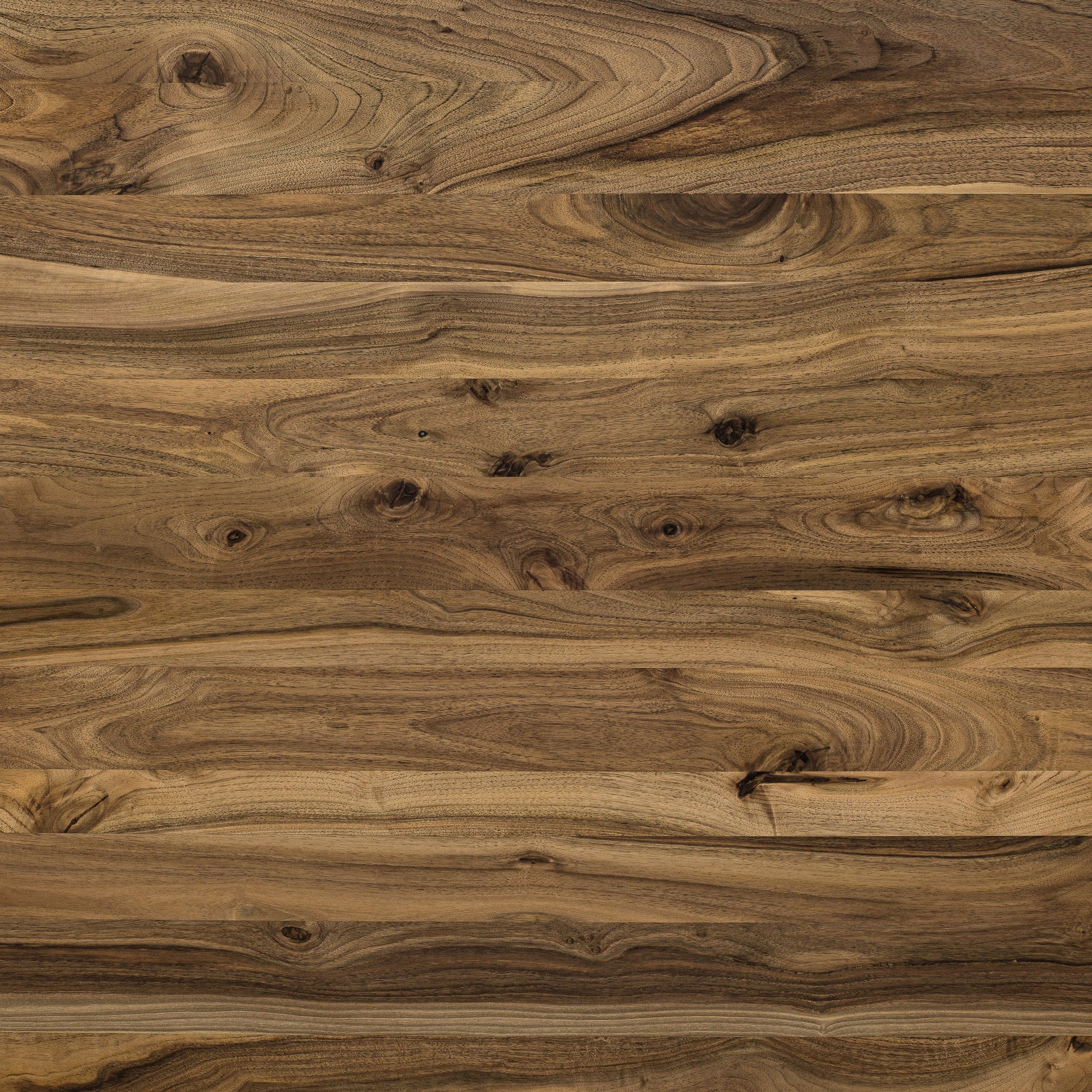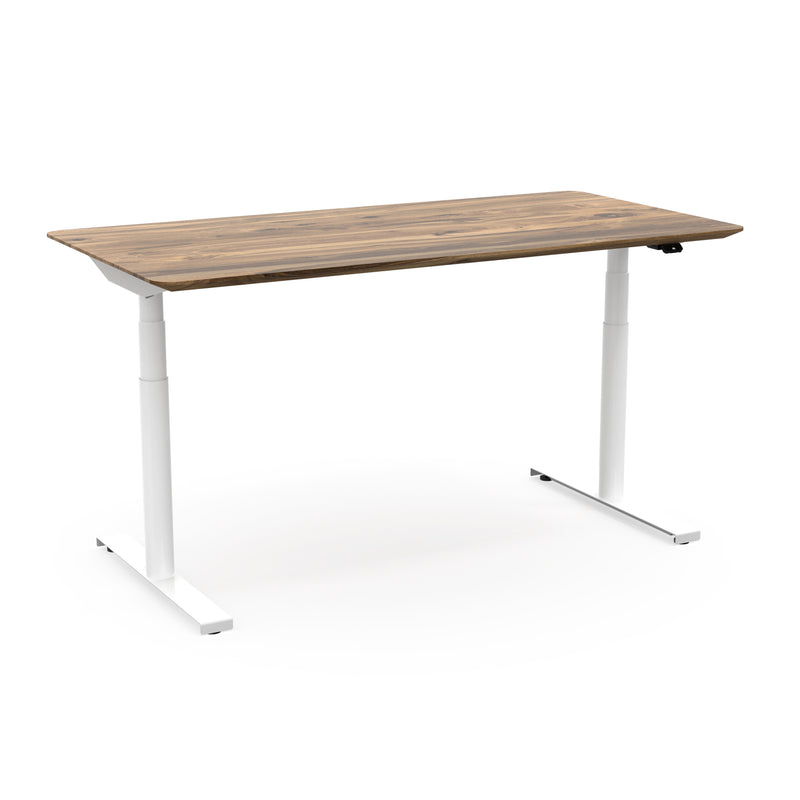European walnut

European walnut is a fine, durable hardwood with a lively, often irregular grain. It is characterised by its natural resilience and good workability, making it ideal for high-quality furniture and interior design. The colour palette ranges from medium to dark brown with grey nuances, giving rooms an elegant, warm atmosphere.
What does walnut wood look like?
Walnut wood is known for its elegant, irregular grain and vivid color variations. The palette ranges from light brown to rich chocolate tones, often with gray or violet hues – and a silky sheen.
As a natural material, each piece of walnut can vary greatly in appearance. Especially with solid walnut wood, no two pieces are alike – each one is unique.
European Walnut vs. American Walnut
Compared to American walnut, European walnut is usually lighter and often shows a livelier mix of colors. Its grain is finer, giving the wood an especially refined look.
| Characteristic | European Walnut (Juglans regia) |
American Walnut (Juglans nigra) |
|---|---|---|
| Color | Light to medium brown, often with gray or violet tones | Dark brown to nearly black, occasionally reddish |
| Grain | Lively, often irregular, sometimes cloudy | More uniform, elegant and deep |
| Hardness | Slightly softer | Slightly harder |
| Origin | Europe, Western Asia | USA, Canada |
| Usage | High-quality furniture, veneers, interior finishing | Luxury furniture, gunstocks, instruments |
| Environmental impact | Good when sourced regionally | Less favorable due to long transport distances |
How is walnut wood treated?
Walnut is typically oiled or waxed to highlight its natural color and grain. Lacquers are used less frequently, as they may mask the wood's character.
Oil protects the surface while allowing it to breathe. Oiled finishes are easy to care for, can be refreshed when needed, and minor scratches are easy to repair. Furniture oil is usually the more eco-friendly option thanks to its natural ingredients.


Environmental footprint of walnut wood
Walnut is a renewable resource and considered one of the more refined and durable hardwoods. Despite its limited availability, it is seen as a sustainable choice – especially when sourced regionally and certified.
1. Sustainable sourcing
European walnut primarily grows in Southern Europe, the Balkans, and parts of Central Europe. As it grows relatively slowly, responsible forestry is essential. Certifications like FSC and PEFC ensure sustainable harvesting and replanting practices.
2. Processing and energy use
Processing walnut wood requires relatively little energy compared to industrial materials. From felling to cutting, drying, and finishing, the energy footprint remains moderate. Regional sourcing further reduces CO₂ emissions.
Thanks to its durability and quality, walnut is replaced less frequently – which also conserves resources.

3. Durability
Walnut wood is known for its long lifespan. It’s stable, dimensionally consistent, and resistant to warping. Walnut furniture retains its beauty and function for decades.
4. Reusability
Most walnut wood is incinerated in biomass power plants via the recycling system and as bulky waste. Although the incineration is CO2-neutral – the walnut tree has previously removed the CO2 from the atmosphere and generates energy – what is more interesting from an ecological point of view is the good repairability of the material. In the furniture sector, in particular, oak can simply be glued, sanded or re-oiled when damaged or worn, and it will look like new again.
5. Biodegradability
Like all solid woods, walnut is a fully biodegradable material. In nature, it decomposes and becomes nutrients for the soil again. Unlike plastic or other synthetic materials, walnut does not leave any toxic residue.
Technical properties of walnut wood
| Property | Value |
|---|---|
| Wood type | Hardwood |
| Density (raw) | 0.60 - 0.70 g/cm³ |
| Compressive strength | 40 - 50 N/mm² |
| Bending strength | 90 - 110 N/mm² |
| Brinell hardness | 26 - 30 N/mm² |
| Modulus of elasticity | 9,000 - 11,000 N/mm² |
| Durability | Good, moderately wear-resistant |
| Weather resistance | Moderate, recommended for indoor use |
| Color | Light to dark brown, often with reddish or violet tones |
| Workability | Very good, easy to plane and sand |
| Uses | Furniture, veneers, interior finishing, woodturning |
Walnut wood at ekomia
Thanks to its noble character and natural beauty, we use walnut wood for our custom tables.
We exclusively use European walnut from sustainable forestry with FSC or PEFC certification. We do not use American walnut due to the long transport distances.
We treat walnut with ecological, vegan furniture oil. This keeps the surface breathable, low-maintenance, and easy to refresh when needed.

Questions & answers for European walnut
Here we answer some questions about European walnut that are frequently asked by other users.
Do you still have any questions?
Do you have any questions or comments on this topic? Write a comment, we will be happy to answer.






